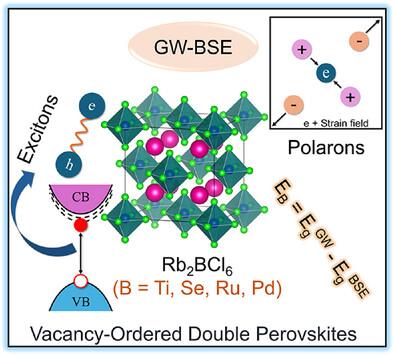探究稳定空位有序双包晶的光电特性:多体扰动理论的启示
IF 2.9
4区 工程技术
Q1 MULTIDISCIPLINARY SCIENCES
引用次数: 0
摘要
空位有序双包晶石(VODPs)为卤化铅包晶提供了既环保又稳定的替代品,因此在科学界引起了广泛的研究兴趣。本研究采用最先进的基于第一原理的方法,特别是密度泛函理论结合密度泛函扰动理论(DFPT)和多体扰动理论(在 GW 和 BSE 框架内),重点研究了作为有前途的光电材料的(B = Ti、Se、Ru、Pd)VODPs。这些计算显示,所有这些材料都具有立方晶格结构,并且在动力学和机械学上都很稳定。有趣的是,除了显示出金属特性外,它们都表现出间接带隙。这些化合物的带隙值在 3.63 至 5.14 eV 之间。此外,BSE 的结果表明,这些化合物在近紫外光到中紫外光区域表现出卓越的吸收能力。此外,对传输和激子特性的研究表明,与空穴相比,它们表现出较低的有效电子质量,激子结合能介于 0.16 和 0.98 eV 之间。一个重要的观察结果是,在这些化合物中,空穴-声子耦合比电子-声子耦合更为普遍。总之,这项研究为指导设计空位有序双包晶石提供了宝贵的见解,这些空位有序双包晶石有望成为未来光电应用的无铅候选材料。本文章由计算机程序翻译,如有差异,请以英文原文为准。

Probing Optoelectronic Properties of Stable Vacancy‐Ordered Double Perovskites: Insights from Many‐Body Perturbation Theory
vacancy‐ordered double perovskites (VODPs) have captured substantial research interest in the scientific community as they offer environmentally friendly and stable alternatives to lead halide perovskites. In this study, the investigation is focused on (B = Ti, Se, Ru, Pd) VODPs as promising optoelectronic materials employing state‐of‐the‐art first‐principles‐based methodologies, specifically density functional theory combined with density functional perturbation theory (DFPT) and many‐body perturbation theory (within the framework of GW and BSE). These calculations reveal that all these materials possess a cubic lattice structure and are both dynamically and mechanically stable. Interestingly, they all exhibit indirect bandgaps, except displays a metallic character. The bandgap values for these compounds fall within the range of 3.63 to 5.14 eV. Additionally, the results of the BSE indicate that they exhibit exceptional absorption capabilities across the near‐UV to mid‐UV light region. Furthermore, studies on transport and excitonic properties suggest that they exhibit lower effective electron masses compared to holes, with exciton binding energies spanning between 0.16 and 0.98 eV. A significant observation is the prevalent hole‐phonon coupling compared to electron‐phonon coupling in these compounds. Overall, this study provides valuable insights to guide the design of vacancy‐ordered double perovskites as promising lead‐free candidates for future optoelectronic applications.
求助全文
通过发布文献求助,成功后即可免费获取论文全文。
去求助
来源期刊

Advanced Theory and Simulations
Multidisciplinary-Multidisciplinary
CiteScore
5.50
自引率
3.00%
发文量
221
期刊介绍:
Advanced Theory and Simulations is an interdisciplinary, international, English-language journal that publishes high-quality scientific results focusing on the development and application of theoretical methods, modeling and simulation approaches in all natural science and medicine areas, including:
materials, chemistry, condensed matter physics
engineering, energy
life science, biology, medicine
atmospheric/environmental science, climate science
planetary science, astronomy, cosmology
method development, numerical methods, statistics
 求助内容:
求助内容: 应助结果提醒方式:
应助结果提醒方式:


